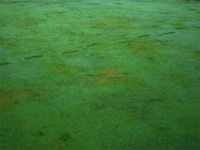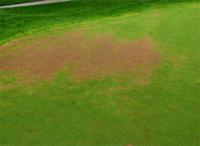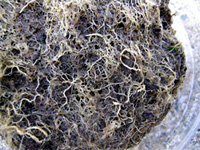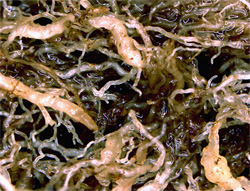
|
Turf Nematodes Typical symptoms of turf damage by plant parasitic nematodes  Heavy turf damage caused by plant parasitic nematodes (Courtesy:Zach Reicher)  Small galls produced by root knot nematode in turf.  Close up of the galls produced by RKN in turf. There are several species of plant parasitic nematodes associated with turf in Indiana. These microscopic soil organisms are not visible and must be isolated from soil around the root area by special laboratory methods. The symptoms associated with these pests are yellow stunted and sometimes wilted grass. These symptoms are often visible in random patches. The symptoms are more apparent when turf is under stress. Plants weakened by nematodes are more vulnerable to other pests as well. Major nematode species known to cause substantial damage to golf courses in Indiana are: Ring Nematode, Stunt Nematode, Lance Nematode and Root Knot Nematode. SamplingSoil samples need to be taken to a root-depth of 4 inches with soil probes. The accuracy increases as more sub-samples are taken. A pint of soil is required for nematode analysis. We recommend a sample from a "good" area and a comparable sample from a "problem" area to better diagnose the problem, especially if the turf has not been analyzed for nematodes recently. Soil samples should not be exposed to high temperature and should not be allowed to dry, as nematodes will not survive these conditions. The most common turf parasitic nematode has been ring nematode followed by stunt nematode. ManagementA soil sampling program on a regular basis, at least once a year, must be established. The best management practice starts with eliminating stress and providing proper fertilization. A restricted use pesticide, like Nemacur, is effective in helping turf for a short period of time. The efficacy of the nematicide needs to be determined by taking soil samples before and after application. |